
The Founding Sisters of St. Francis Hospital
(written by Sarah Ludington, Archives staff)
In 2022, Mayo Clinic Health System – Franciscan Healthcare broke ground into the block bounded by West Avenue and Mississippi Street to expand its services and opportunities for the La Crosse community. This means that by the medical center’s 140th anniversary at the end of this year, it will have grown to nearly four city blocks. For many casual passersby, it’s probably hard to imagine that somewhere under the great conglomerate of red brick, concrete, and time was the footprint of a simple three-story structure that served as La Crosse’s very first hospital. And none of it would have been possible were it not for the vision and devotion of an order of Franciscan Sisters “to teach, care for orphans, and minister to the sick.”
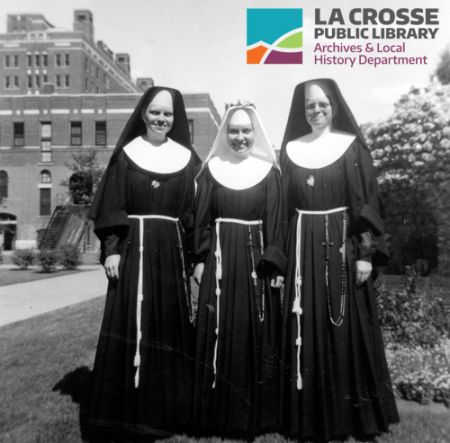
A trio of Franciscan Sisters stand in the garden of the St. Rose Convent
The Sisters would come to be known as the Franciscan Sisters of Perpetual Adoration or FSPA. Perpetual adoration refers to the continuous prayer that occurs in the chapel by nuns and volunteers. Prior to taking religious vows, the original six sisters were Bavarian immigrants who arrived in Milwaukee in 1849. Their intention was to help build a church that would eventually include their convent, a seminary and an orphanage. However, they found the working conditions a challenge. According to Franciscan Skemp Healthcare: A History by Susan T. Hessel,
“Conditions were primitive. Cholera took the lives of two priests in 1851. Stories have been told of the sisters who worked from morning until night cooking, cleaning and farming, falling asleep in the midst of laundry.”
Over a decade passed, and while the order grew in number many of the original members of the order chose to leave and live their lives as “lay women”, no longer part of the religious order. The women felt stagnant in their effort to fulfill their mission. The rest of the group, led by their Mother Superior, would also eventually leave Milwaukee, but did so in order to achieve at least a part of their goal. They built a school in Jefferson, WI serving the German Catholic population there. However, there was still that tenet of their mission to minister to the sick. So, despite their success in Jefferson, when the opportunity arose in 1871, the sisters relocated to river city of La Crosse.
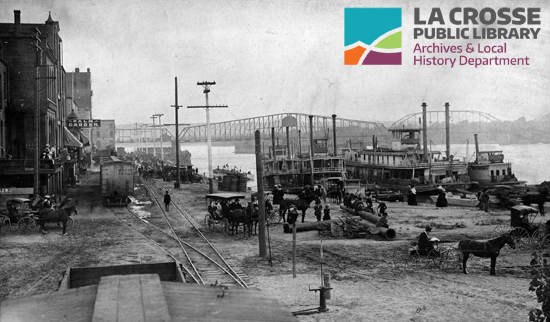
La Crosse riverfront scene in the late 19th century
By 1873, La Crosse had become an official port on the Mississippi River and the third busiest one at that time after New Orleans and St. Louis. With that distinction came a responsibility to the marine workers who worked on the steamboats moving goods along the river. A hospital fund had been created to pay for the care and boarding of these workers. In 1874 the La Crosse newspaper, The Daily Liberal Democrat, reported:
“Each boat enrolled here pays 40 cents per month dues to the hospital for each man employed, which creates the fund…”
The “hospital” referred to was not yet a physical space. Workers would be lodged in boarding houses like the State Street House until they were well. A dedicated space was sorely needed.
City officials approached the sisters about working together to build a hospital. The FSPA and the Diocese of La Crosse were in favor of being involved in building a hospital; it was part of their mission. However, they would also need approval and funding from the archbishop in Milwaukee, and he was not supportive of the project. Hospitals did not have the reputation then that they have today for care. They were seen as places where people who were ill would go to die. It was this reputation that the sisters were up against in asking for the financial support of the organization.
However, they had the support of the city itself and a strong advocate in their Mother Superior. A budget was agreed upon and the location secured. Even as the ground was broken on the block fronting Market Street between 10th and 11th, The Morning Chronicle reported on the progression as a highly anticipated topic, stating: “La Crosse is at last to have a public hospital,” and, “The enterprise is one of lasting importance to the city and surrounding country, and no doubt will prove its necessity from the outset.”

The original hospital building, facing Market Street
The plan for operating the hospital was to hire a few doctors and to train some of the sisters as nurses. Dr. Charles Ottilie, who would later become the chief surgeon, was quoted as saying “give me two energetic sisters and I will instruct them!” According to a few sources, one of those two sisters (though there were probably more) was Sister Theodora Burns. She had entered the St. Rose Convent less than a week before St. Francis Hospital was due to open its doors. Along with Sister Mary Mathilda Lang, she was trained by Dr. Ottilie in basic nursing skills. The nurses-in-training would go on to attend classes and lectures given by Dr. Ottilie and others in chemistry, clinical & practical nursing, and “materia medica”, an early term for what would become the field of pharmacology.
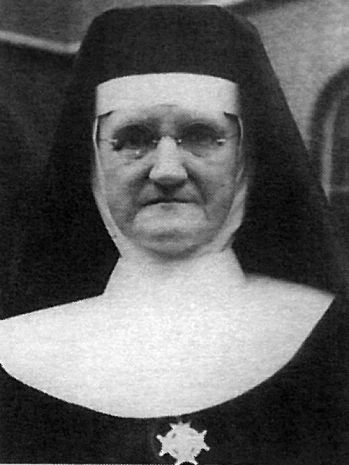
Sister Theodora Burns
Photo from the book Franciscan Skemp Healthcare: A History
In 1886, as the hospital was already eyeing physical expansion to accommodate demand, the sisters were expanding their skillsets. Sister Mathilda took exams to become a registered pharmacist that year and received the highest scores. According to the book A Century of Health Care Ministry, it is likely that Sister Mathilda was the first registered hospital pharmacist in Wisconsin. Sister Theodora would follow in her footsteps five years later. She would go on to become Sister Directress of the Hospital Pharmacy.
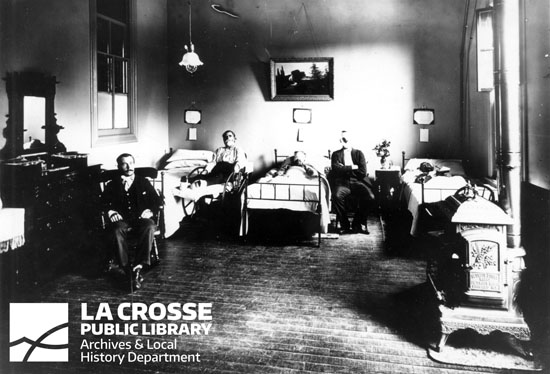
St. Francis Hospital Men’s Ward, ca. 1900
Though the marine ward was a major factor in the beginning of the hospital, the decline of freight moving along the river did not impact its necessity. As the railways moved through La Crosse, “marine boys” became “ticket boys” and St. Francis would continue to provide accommodations. In the 20 years from the opening of the hospital until the turn of the century, La Crosse’s population would increase by 50%. There was no shortage of patients, but only so many nurses to tend to them. In 1901, the training provided to the sisters was opened to the public to meet the growing need for nurses. The following year the St. Francis Training School for Nursing opened, and Sister Theodora was among the first sisters to instruct them.
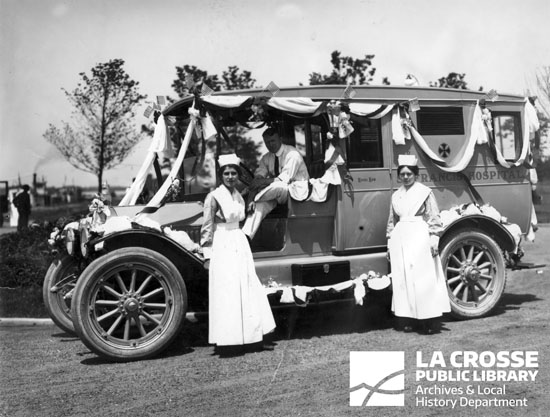
Nurses stand in front of the St. Francis ambulance at a July 4th parade in 1914
From 1912 through 1932 Sister Theodora Burns served as hospital administrator and in that time, the hospital faced challenges and innovations. Four major additions would happen during her tenure. In 1912, St. Ann’s Orphanage, which was across Market St. would be converted into a maternity ward. Fifteen years later, as the population grew it became necessary to build a modern maternity hospital in place of the old orphanage building. In 1916 expansions were made on both east and west wings of the hospital, just before the outbreak of the Spanish flu pandemic two years later. 1931 saw the largest change to the hospital yet: an 8-story addition was added altering the entrance of the hospital to the west side, onto 11th St, and necessitated the destruction of the original building.
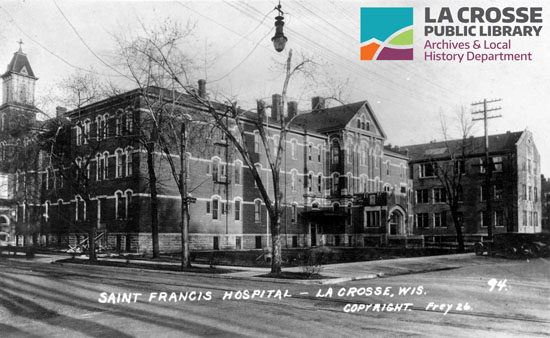
A view of the 1916 expansion of the west wing of St. Francis Hospital
Meanwhile, the nursing school continued to grow, shifting from teaching in the hospital itself to dedicated space in the basement of the new maternity hospital in 1927. The first class in 1902 consisted of sixteen students, five of whom were Sisters. The number of students increased so much over the next thirty to forty years that a problem arose with housing the nurses and in the late 1930s the school was threatened with closing if the facilities were not improved. So, in 1941 a permanent location was built for the St. Francis Training School for Nursing. The following year the school would dedicate the building and formally change the name to the St. Francis School of Nursing.
Sadly, Sister Theodora would not live to see the opening of this new chapter of the school which she helped facilitate. In 1938, she passed away in the hospital that had become, as was written in her obituary, “the story of her daily life.” Eleanor Skemp, the daughter of Dr. A.A. Skemp, who would soon go on to influence another part of the story of St. Francis Hospital, wrote an appreciation of Sister Theodora Burns upon her death including the sentiment:
"It so happened that part of her soul was used as the cornerstone of St. Francis' hospital and the other part was used to build and rebuild the broken spirits, and the damaged hopes, and the little dreams of people who came in and then went out again."
St. Francis’ story of care and growth continues next week as we move into next part of the 20th century.
